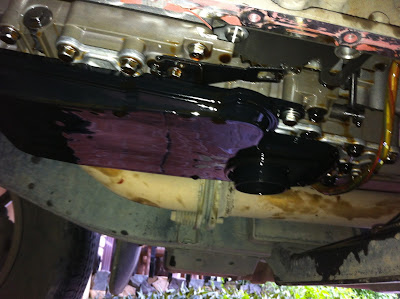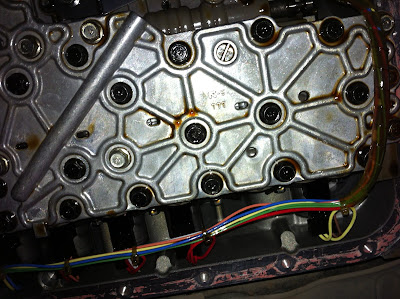To begin with, I am sorry to disappoint the destruction fanatics with this post. As opposed to destroying something recently,I have actually improved an object of significant worth to us. And to be honest, I would prefer to see more of these types of posts.
 |
| The err gold..brown..green..Montero Sport. Straight out of the jungle. |
I drive a 2009 Mitsubishi Montero Sport. This 7-seater, sport-utility vehicle (SUV) has a 2.5L direct injection diesel engine, and has an automatic transmission. It's quite a reliable vehicle as it is both economical and safe - albeit there are some isolated reports of Sudden Unintended Acceleration (SUA) accidents you can find on news sites which are also tested by some on Youtube. It's mileage is now running at 47,000km and I knew it was already due for a change in its AUTOMATIC TRANSMISSION FLUID (ATF) and ATF FILTER. Most, if not all, of the car enthusiasts would have their cars serviced by authorized dealers. I think this is always the best route. But for me, aside from just trying to save on budget, my curiosity simply just got the better of me.
So I bought the necessary materials for my "operation" a few days before the weekend. I was able to source the OEM transmission fluid and its filter, a silicone gasket maker, and a funnel to help me pour the fluid into the dipstick tube. I also prepared the hydraulic jack, wrenches, sockets, pliers, and some cleaning materials.
So I started by lifting the vehicle a couple of inches higher off the ground to create some clearance underneath. I would suggest that you try to lift it up as much as you can, otherwise you would be working your butt off literally, commando style, or like an upside down frog (you know, the ones you run over the highway). I began the more difficult work by removing the front bash plate. There were actually two of them at the bottom, so I took both of them off to expose the transmission coolant hose.
 |
| The transmission coolant hose line |
I released the clamp with the use of some pliers and disconnected the rubber hose from the metal tube that lead to the radiator. I connected the metal tube to a small hose that lead to my oil basin. I released the Kracken err- the hydraulic jacks to restore the vehicle to its normal angle. I then started the vehicle at the Neutral position, and the old transmission fluid started to drain out of the hose line, which lead to my basin. After draining the fluid and switching the engine off, I transferred the old fluid with the use of a funnel to some empty soda bottles - these were 2-liter bottles - so that I could have an idea of how much fluid would be replaced. I was able to drain out 4 liters of the old transmission fluid.
I had to lift the vehicle again to be able to commando crawl - yes like the upside down frog - under the vehicle and loosened the transmission drain plug. I placed my catch basin underneath the area of the plug and then lowered the vehicle once again. I also took out the dipstick from the transmission tube to allow the flow of fluid out of the drain.
After draining, I raised the vehicle to start loosening the bolts so that I could take out the transmission pan. This was a bit more difficult because of the space constraints, the tension on the bolts, and the gasket. I was finally able to remove the bolts - except for one on each of the sides, I just had to make sure that the pan doesn't just fall off completely - and the pan was still too difficult to pull out. It turned out that the gasket was really tough to take off, and the pan was not budging at all. I used a couple of flat head screwdrivers to slowly create some leverage at one corner of the transmission pan. Eventually, after a couple of wedging, I was able to take out the pan and pour the remaining fluid inside of it, into my basin.
 |
| The exposed ATF Filter after the pan is removed. Watch out for drippings! |
 |
| The pan with the magnets and a little fluid left |
The transmission pan contains 3 magnets. I would assume that these magnets attract the metal filings within the fluid to help the filtration process, maintain viscosity, and avoid damaging the transmission gears. I found the magnets to be quite dirty or grimy, with very fine materials attracted to it. I also checked the pan for any large metal filings that could indicate damage within the transmission. The good news was, there weren't any.
 |
| So that's how dirty the magnet was. That's also how dirty my fingernails were. |
I took out the 3 magnets, bearing in mind it's locations, and easily cleaned each one of them by wiping away the grime. I also cleaned the pan thoroughly, and started working on the silicone gasket around it. It took quite some time to take it all out from the sides of the pan because of how much material was on it. I removed the old ATF filter - it was secured with 2 bolts that I kept - and pulled it out from the transmission. It contained some of the fluid so I had to drain it into the basin as well.
 |
| The discarded ATF Filter. Out with the old- |
|
 |
| -and in with the new. The new ATF Filter. |
I also had to take out and clean the gasket material on the sides of the transmission and wipe away any visible grime with a clean piece of cloth.
 |
| I really tried to make it as clean as I could |
I then installed the new ATF Filter and used the bolts I got from the discarded filter.
 |
| With the new filter installed |
At this point I just wished I could afford my own creeper. My back, both of my arms, and my neck were killing me. But since I already got this far, I was determined to soldier on. So now that the pan was clean, I applied the new silicone gasket maker on the sides of the pan. I found varying opinions on how much sealant to place, but I decided to put a continuous bead sized application of it, all over the sides. And when everything was done, I put the pan back on the transmission. Two things I would notice would be: First, since the pan was colored black, perhaps next time, I should use a different colored silicone gasket maker, maybe a pink colored one, or a brown colored sealant. I think a similar colored sealant would be difficult to spot the next time I would try to clean it. The second observation would be that even the bead sized application was seeping out of the sides as I tightened all the bolts in.
 |
| So now my aching body could not even take a decent photo under the vehicle |
So now that the pan was back in its place, I lowered the hydraulic jack and prepared to pour in an initial amount of the new ATF - I think I poured in about 3 liters of the new fluid. I used a funnel to pour in the new ATF through the ATF dipstick tube. I then started the vehicle at the Neutral position and drained the remaining old fluid via the hose that I set-up at the transmission coolant line. I was able to drain another 1.5 liters of the old fluid from it. I "guess-timated" that there was close to 5.5 liters of the old fluid that I drained, therefore, I needed to replace it with the same amount of the new one. Since I had 3 liters already, I just needed to add about 2.5 liters. Prior to adding the remaining amount, I had to reconnect the transmission coolant line, which means I had to reconnect the rubber hose to the metal tube and reattach the clamp on it so it doesn't leak.
 |
| The ATF SPIII that I used |
Pouring in the final 2.5 liters had to be done in a painstaking manner because I didn't want to overfill the ATF. So I had to pour in a few amount every time and then check the level again with the dipstick. I was also shifting through the gears at certain points - meaning I shifted around P-R-N-D a couple of seconds each gear- all these with the engine running.
When I was able to achieve the right level, I put everything back in its place. I had to take the vehicle for a test drive to see if there were any problems, and the good news was that there weren't any problems. After I parked the vehicle, I checked for any leaks under the vehicle as well.
It has been almost a week since I did the change, and so far so good. The transmission seems to be a lot smoother and I haven't encountered any problems with the vehicle. I just hope it stays this way, so I'm keeping my fingers crossed! Next up, the engine oil, but maybe after my sore back recovers from all this "upside down frog"-ing around.











Nice article. This is so much more than I needed! But will all come in use thanks!
ReplyDeletetransmission rebuilding tools
Nice post thanks for sharing.
ReplyDeleteAR engineering is one the the best vaccum pressure impregnation plant manufacturer in pune,Maharashtra and India.They provide the best quality of vacuum pressure impregnation plants,Evacuation System for Transformers, Transformer Oil Filtration Plant.
vacuum pressure impregnation plants
Evacuation System for Transformers
Transformer Evacuation System
Transformer Oil Filtration Plant
Transformer Oil Filtration System
Industrial Oil Filter Machine
Two Stage Transformer Oil Filtration Plant
Transformer Oil Cleaning Systems
Turbine Oil Filtration Plant
2 thumbs up for this, thanks bro!
ReplyDeletenow i begin to think about doing what you did!
ReplyDeleteThanks for Shearing This Post
ReplyDeleteAR Engineering is a manufacturing of transformer oil filtration machines. The plants are suitable for Transformer & Capacitor Manufacturers,Oil filtration service providers etc.
High Vacuum Transformer Oil Filtration and Dehydration Plants
Varnishing Machines :-
Trickle Impregnation Technique
Batch Type Trickle Impregnating Machine
Index Type Trickle Impregnating Machine
Vacuum Impregnation Plants / Pressure Impregnation Plants
Industrial Oil Purification Systems
good day, may I know what type of atf did you used? thank you so much it help a lot.
ReplyDelete
ReplyDeleteDiscover how our filtration plant solutions can benefit your business. We offer a range of solutions for industrial clients, including our high vacuum-based transformer oil filtration plant